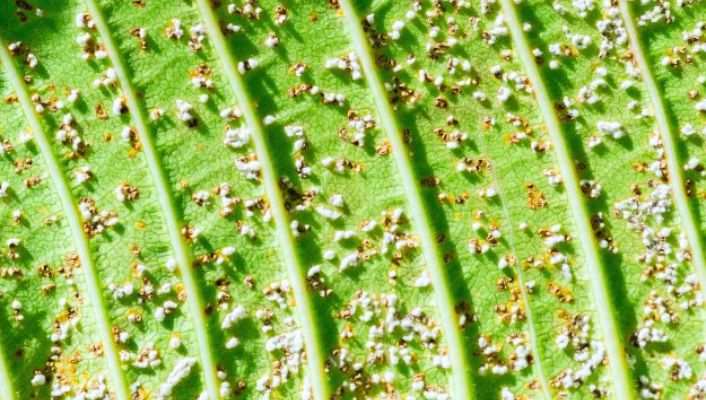The beauty of a plumeria plant in full bloom is a sight to behold. Its vibrant colors and fragrant scent make it a popular choice for garden enthusiasts. However, the plumeria plant is not immune to the threat of an aphid attack. These small insects can quickly wreak havoc on the plant’s leaves and stem, causing unsightly damage and stunting growth.
For gardeners who have invested time and effort into nurturing their plumeria plants, an aphid infestation can be devastating. But fear not, there are solutions available to fight back against this pest. From natural predators to organic insecticides, there are various treatments and preventative measures that can be taken to keep your plumeria plants healthy and thriving.
In this article, we will explore the causes of aphid infestations, the signs and symptoms of an attack, and the treatment and prevention options available to combat this common garden pest. We will also delve into the efficacy of organic solutions for aphids, providing readers with the information they need to make informed decisions about how to protect their plumeria plants.

Causes of Aphid Infestations On Plumeria
The causes of aphid infestations, which can quickly build populations on plumeria at all stages of life and restrict overall plant health, have been previously discussed. However, there are additional factors that can contribute to the appearance of aphids.
Identifying aphid predators and providing a healthy environment for plumeria can help to prevent and control aphid infestations. One way to prevent aphid infestations is by identifying and attracting natural predators, such as ladybugs, thrips, and wasps. These insects can help to control aphid populations by feeding on them.
Additionally, providing a healthy environment for plumeria can help to prevent plant stress, which can attract aphids. Overwatering, in particular, should be avoided, as it can make plumeria more attractive to aphids. By reducing plant stress and encouraging natural predators, gardeners can effectively manage and prevent aphid infestations.
Signs and Symptoms Aphid Attack On Plumeria
Symptoms of an infestation by this common plant pest often manifest as wrinkled and puckered leaves, along with pale foliage discoloration and chewed areas. Aphids, attracted to new growth, feed on sap and can quickly build populations on plumeria at all stages of life. Over 200 species of aphids exist, with white sap-sucking aphids being the most common. However, they can be mistaken for clumping molds on heavily infested areas. It is important to identify aphids correctly to deal with the infestation effectively.
Dealing with aphid damage is crucial to restoring the overall health of the plant. Early signs of damage include pale foliage discoloration and chewed leaves. Late-season aphids can lay eggs that hatch quickly into a mix of winged females and males, causing foliage discoloration on late-season growth. If left unchecked, aphids can restrict plant health and growth. It is essential to understand the long-term effects of aphid infestations and take preventive measures such as organic insecticides, horticultural soap, and neem oil.
However, it is important to avoid common mistakes such as spraying aphids off plants as they can find their way back. Providing good ventilation, releasing natural predators of aphids, and finding the right balance of plant food early in the season can help reduce chances of an aphid infestation.
Treatment and Prevention Options
Among the various treatment and prevention options for aphid infestations, incorporating sacrificial plants and removing aphid eggs over winter can be an effective organic approach. Companion planting is a technique that involves planting certain plants alongside others to benefit their growth and repel pests.
Planting companion plants such as marigold, chrysanthemum, and nasturtium can help repel aphids by emitting strong scents that they find unpleasant. Additionally, these plants can attract natural predators of aphids, such as ladybugs and lacewings, which can help to keep the aphid population under control.
Another effective method for preventing aphid infestations is to remove aphid eggs over winter. Aphids can lay up to 80 eggs during their lifecycle, and these eggs can remain dormant in the soil for up to four months. By removing the surface layer of soil from plumeria in late winter while the plant is dormant, gardeners can destroy overwintering eggs from the soil easily.
This can help to reduce the population of aphids in the garden and prevent future infestations. By incorporating these organic prevention methods, gardeners can effectively manage aphid infestations and cultivate a healthy and thriving garden.
| PROS | CONS |
|---|---|
| Effective organic approach | May not work for severe infestations |
| Attracts natural predators of aphids | Companion plants may not be aesthetically pleasing |
| Helps to repel aphids | Requires additional planning for companion planting |
| Can provide a diverse and beautiful garden | Requires regular maintenance and monitoring to ensure success |
Organic Solutions for Aphids
In the context of managing plant pest infestations, incorporating organic solutions can be an effective approach to prevent and treat aphids.
One such solution is using essential oils to deter aphids. Peppermint oil, for example, can be diluted and sprayed on plants to create an unpleasant environment for aphids.
Additionally, using companion planting strategies, such as planting marigolds or garlic next to plumeria plants, can help repel aphids naturally.
Another organic solution for aphid infestations is introducing natural predators into the environment. Ladybugs, thrips, and wasps are all known to feed on aphids and can be introduced into the garden to control their population.
Organic insecticides, such as horticultural soap made from natural ingredients like castile soap or neem oil, can also be effective in treating aphids. However, it is important to use caution when applying these solutions, as they can be harmful to beneficial insects like bees and butterflies.
In addition to addressing aphids on plumeria, it’s crucial to ensure proper care and maintenance of your plants. One essential aspect is plumeria repotting. Learn how to repotting plumeria effectively to promote healthy growth and prevent pest-related issues like aphids. Check out our guide on plumeria repotting for step-by-step instructions and expert tips.
Conclusion
Despite aphid attacks on your plumeria plants, you can fight back and ensure their health. Understanding the causes, signs, and symptoms of aphid infestations enables you to take timely action. There are several effective strategies to combat aphids, including attracting natural predators, using organic solutions, and practicing companion planting. Choose the methods that align with your preferences and prioritize the well-being of your plants. With diligence, you can overcome aphid challenges and enjoy the beauty of your thriving plumeria plants.

